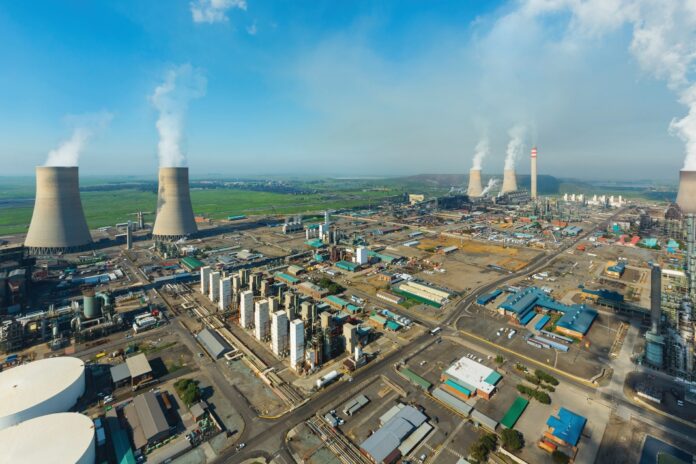A series of international and domestic partnerships that Sasol has signed in recent months illustrate that the company has decided that the energy future must be markedly different to the present. A disruption of the company’s AGM by climate activists and doubts about the company’s carbon-reduction strategy expressed by some big investors have helped bring that awareness to broader public attention.
International chemicals and energy company Sasol has several large plants in the Free State and Mpumalanga (pictured), and is the dominant national player in these sectors. Products manufactured by Sasol include synthetic fuel, petroleum, paraffin, jet fuel, creosote, bitumen, diesel and lubricants. The primary feedstock for synthetic-fuel production is coal. With more than 30 000 employees and a presence in 30 countries, the decisions Sasol makes have a big impact.
Subsidiary company Sasol ecoFT is producing sustainable fuels and chemicals from green hydrogen and sustainable carbon sources via the Power-to-Liquids process and using the Fischer-Tropsch technology (FT) which has helped set the company apart in its field.
In 2010 Sasol flew the world’s first passenger aircraft using fully synthetic jet fuel and it has been investigating solutions ever since. Sasol is part of a consortium based at its Secunda operations called HyShiFT with Linde, Enertrag and HydRegen, a spinoff company from the Department of Chemistry of the University of Oxford. The project aims to invest in about 500MW of renewable energy that will supply a 200MW electrolyser for green hydrogen production, resulting in approximately 45 000 tons a year of sustainable aviation fuel (SAF).
In 2021, agreements were signed with Toyota and the Industrial Development Corporation (IDC) relating to green hydrogen and Sasol joined the Hydrogen Council.
A market for carbon credits has been created.
With the IDC, Sasol aims to develop a green hydrogen market in South Africa, develop policy guidelines, support pilot projects and investigate funding options for the nascent sector. One such project involves investigating the possibilities of developing a Special Economic Zone (SEZ) in the Northern Cape dedicated to the production of green hydrogen. The feasibility studies regarding the Boegoebaai SEZ are ongoing and Sasol is a key player in this potentially transformative project.
Battery storage is increasingly becoming an important part of hybrid projects and a move in November 2023 by the JSE, Africa’s biggest stock market, signalled another landmark on the renewable energy landscape. JSE Ventures has initiated a Voluntary Carbon Market together with US company Xpansiv, with the aim of creating a market for carbon credits.
Generation plans
When big companies start investing in a sector, then it’s clear that that sector should be taken seriously. Resources company Exxaro started investing in renewable energy earlier than most. Rolling blackouts have been a feature of South African life since 2008 and the Renewable Energy Independent Power Producer Procurement Programme (REIPPPP) was introduced in 2011 to encourage the private sector to start generating power. Exxaro subsidiary Cennergi’s bid to produce power in the Tsitsikamma area of the Eastern Cape via a 95.3MW wind farm was accepted by the Department of Energy in 2012. Since then, the 134.4MW Amakhala Emoyeni has been built in the Bedford area and Cennergi Services has evolved into a company that builds, manages and operates renewable energy projects that it owns as well managing assets for third parties. It has seven projects in four provinces.
Exxaro’s huge coalmine at Grootgeluk in Limpopo (which supplies Eskom power plants) will be the site of an 84MW solar project and Northam Platinum is building a 10MW solar plant at its Zondereinde smelter. Implats is using natural gas to supply its refinery in Springs. In Phase one of the project 20 Doosan fuel cells are generating 8MW of power. The long-term goal is to generate 22-30MW.
Certain manufacturing companies that have access to biomass that results from the manufacturing process, such as woodchips for Sappi and bagasse in the case of sugar producers such as Tongaat Hulett and Illovo, are in a position to produce their own energy.
However, there are industries where signing offtake agreements with renewable energy producers is the more logical route to take. In fact, even PGM miner Ivanhoe Mines, despite having its own plans to produce solar power, has signed an offtake agreement with Renergen in order to have access to that company’s electricity powered by renewable sources.
Amazon has signed deals to have exclusive rights to renewable power produced from dedicated projects in the Northern Cape. Telecoms market-leader Vodacom has gone beyond the idea of having a single power producer. In a landmark deal brokered in 2023, Vodacom and Eskom have agreed to “virtual wheeling” whereby Vodacom will source power from multiple independent power producers.
Wheeling refers to sending power through the grid. At the moment Eskom is the sole owner and operator of the national grid. The Department of Public Enterprises intends for Eskom to be broken up into separate entities, one of which would be a transmissions company.
The City of Cape Town has initiated a pilot project whereby 15 commercial suppliers can sell electricity to third parties via the city’s grid, a development that will be very closely watched. The chair of the South African Independent Power Producers Association, Tommy Garner, told the Sunday Times, “It is very important for the electricity market in South Africa that you split Eskom into three entities.”
Online Resources
-
- HyShiFT: www.hyshift.org
- National Energy Regulator of South Africa: www.nersa.org.za
- South African Independent Power Producers Association: www.saippa.org.za
- South African Wind Energy Association: www.sawea.org.za








